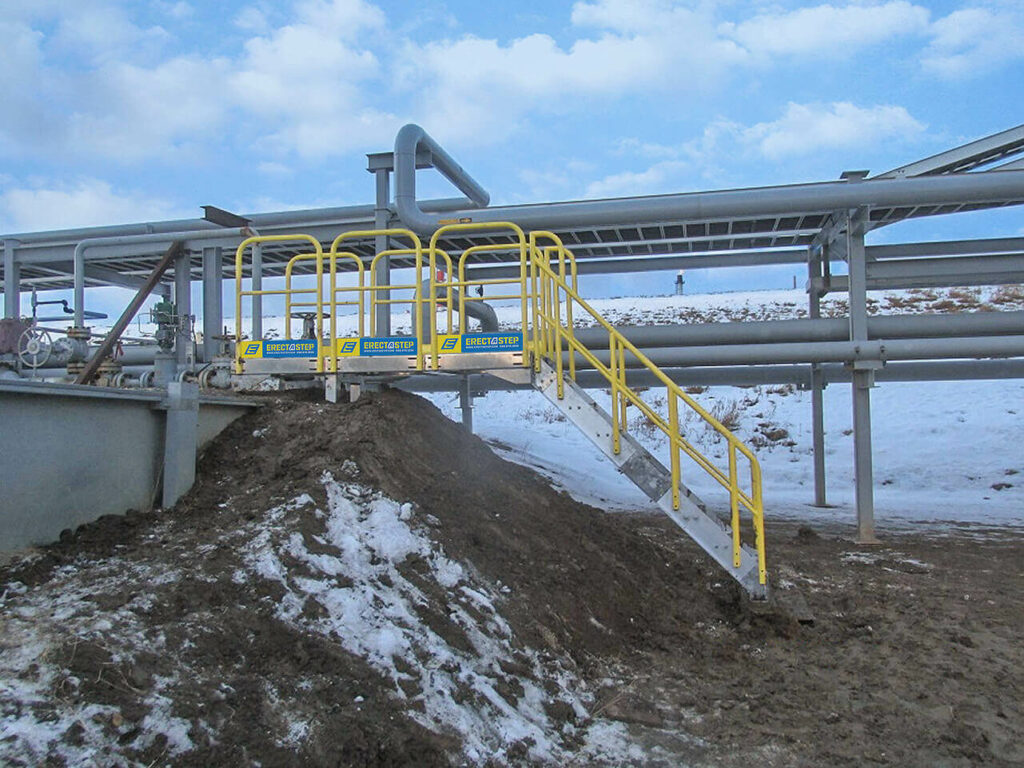Get a quote, configure a custom stair or ask a question. We're here to help!
Erectastep Maintenance Access Stairs Provide Safe Workplace Around Berms in Pembina
View All Industrial%20Stairs InstallationsPembina Pipeline Corporation operates around an oil transporting pipeline system, they need safe access across the meandering hefty pipes and uneven landscapes.
A berm is similar to a dike because it is a barrier that keeps liquids from escaping. It is a raised border separating different areas that may provide additional protection from flooding or erosion; berms are constructed from various materials, including gravel, stone, soil, crushed rock, or a combination of these materials. When soil is used for berm construction, it is typically of the silt or clay type mixed with earth or gravel. Designed to be of sufficient height to prevent water from overtopping it, the berm’s width at the top is approximate twice its height. This design helps to ensure that it will withstand the liquid’s force without being eroded or toppled over. Oil and gas companies can create berms manually or with the help of machinery.
Many industrial accidents happen because workers don’t know how to recognize threats of working around berms. Mostly found in industrial backdrops like factories, wastewater treatment plants, and oil refineries, berms can vary in size and shape, but they all serve the same purpose. Unfortunately, many workers don’t know how loose or wet soil can cause walkways and equipment to collapse, which can lead to accidents, injuries, and even fatalities. Aside from spill containment, the workplace with berms should also incorporate fall protection equipment to avoid expensive worker compensation liabilities. To prevent these accidents, employers must provide berm training and risks associated with working within these structures.
The Occupational Safety & Health Administration (OSHA) classifies berms as passive secondary containment. However, OSHA standard 1910.120 Appendix C emphasized that facilities should implement a spill containment scheme in areas wherein industrial operations may accidentally discharge hazardous chemicals, especially when conducting bulk chemical loading operations. Additionally, facilities should display hazmat placards with UN numbers to remind workers what bulk chemical they are dealing with, and they can take precautions based on their training.
Like the Pembina Pipeline Corporation, which transports hydrocarbon products through its network of terminals around North America, they integrated Erectastep maintenance access platforms to provide safe routes in multiple locations blocked by their pipes.
There are a lot of metal stairs on the market, but what makes Erectastep different is our commitment to quality. Proudly prefabricated in the USA, we only use the best materials, and our team of skilled designers takes the time to make sure every step your worker takes in your facility fulfills our high standards.
Above all, our stair components are modular and made of aluminum. Here are the advantages of using aluminum vs. steel stairs:
- Aluminum stairs are lighter than steel, making them easier to transport and install
- They are also more corrosion-resistant, meaning they will last longer in even the harshest environments
- Aluminum stairs are non-conductive, making them ideal for use in electrical areas
- Their sleek finish and slip-resistant steps make them a popular choice for almost all commercial applications
We also offer various customization options to choose the perfect work platform for your needs. Whether you need a metal stair for a commercial or industrial setting, we have a solution that will work for you. Contact us today to learn more about our metal stairs and how we can help you achieve your goals.









